Caiden and Emily are two legally blind high schoolers from Fishers, Indiana. Caiden is a pianist, a poet, a philosopher, and a martial artist. You can check out more of his life, works, and reflections on his Instagram. Meanwhile, Emily looks forward to attending Indiana University to study International Law and Institutions with her new guide dog. In her free time, she enjoys taekwondo, horseback riding, and participating on her high school academic team!
Blind in Indianapolis: Navigating IndyGo as a Visually Impaired Rider
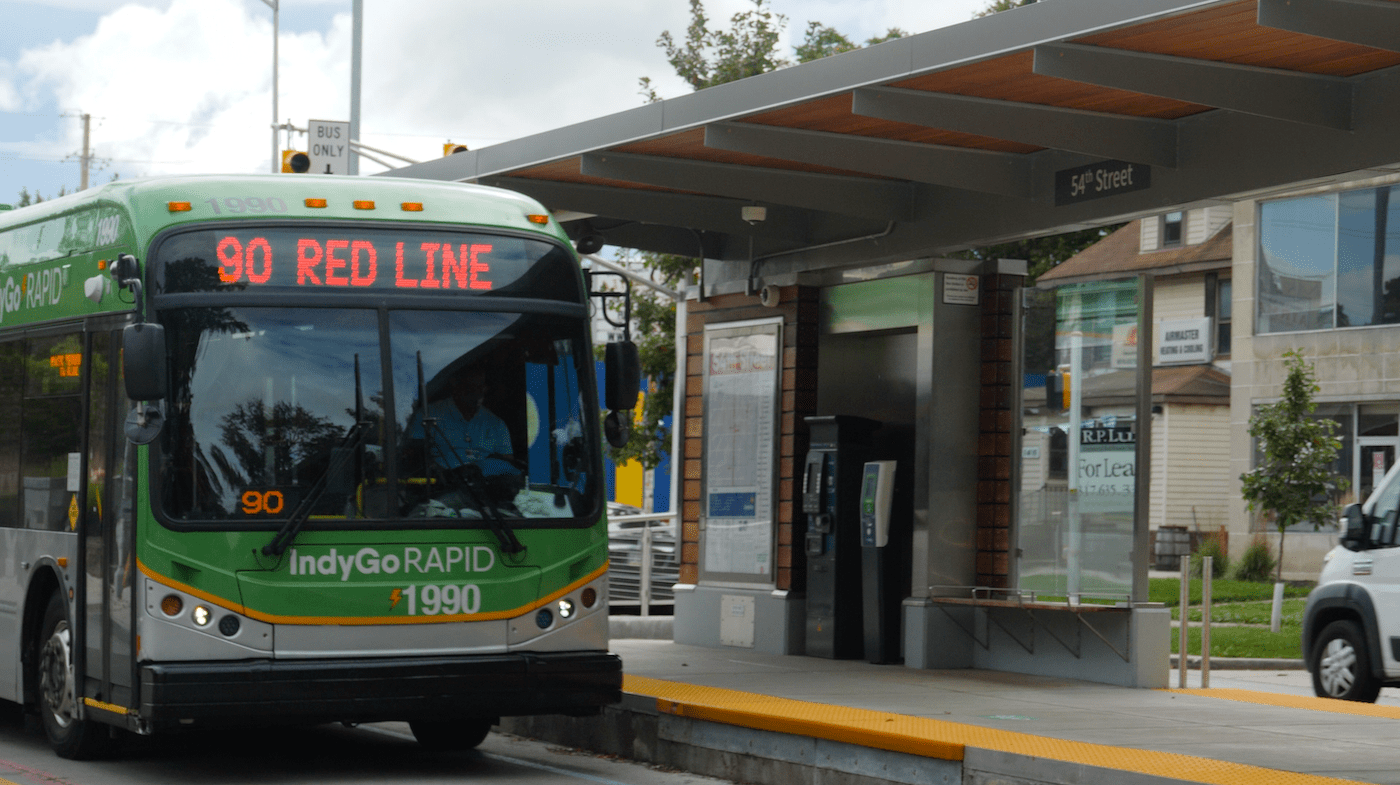
In 1990, The Americans with Disabilities Act—more commonly known as the ADA—made it illegal to discriminate against workers on the grounds of their impairment. However, there are still numerous barriers to work for the blind and visually impaired.
The estimated rate of unemployment is difficult to determine with complete accuracy, but studies estimate an exceptionally high rate for blind and visually impaired Americans. The National Federation of the Blind even reported that a staggering 70% of visually impaired citizens lack full-time employment.
Many factors influence this statistic, but one of the most notable barriers to employment is transportation. As one might expect, it becomes hard to hold a job if you can’t reliably show up to work. That’s why it’s imperative that every city maintains a strong public transportation system that’s accessible to everyone.
But before we go any further, introductions are in order! I’m Caiden Cawthon, writing with Emily Nelson. We’re two legally blind 17-year-olds from Fishers, Indiana. Right now, I’m in my junior year of high school, while Emily’s in her senior year. We’re both very academically inclined, looking into a variety of universities as we try to find our place in the world.
Recently, our Orientation and Mobility teacher, Tommie Roesch, organized a day of adventure to help prepare us for the real world of college and beyond. She took us to downtown Indianapolis with our friend Morgan, so we could practice using our white canes in conjunction with the IndyGo bus line. From lunch plans to arcade games, Ms. Roesch had great things in store for us!
Our IndyGo adventure begins at the crosswalk.
If you’re not familiar with Indianapolis, IndyGo is the largest public transit provider in the state. They operate a network of bus routes across the city, providing an easy way to explore downtown for just a small fare.
Emily has used the kiosk to buy a pass before, but now, the MyKey app makes it much easier for us to order a ticket. The app lets you pay the fare from your smartphone, which is great for accessibility. But our next challenge was the bus stop itself!
The stop was actually in the middle of the street, which was quite shocking for all of us from the suburbs. Our instructor had to tell us that we were in the middle of the crosswalk, instead of the usual spot on the side of the street. Fortunately, we found another great piece of assistive technology to help us—truncated domes.
“Truncated domes” is the term for the raised bumps on sidewalks. They help blind and visually impaired people identify where the curb ends and the crosswalk begins. In urban areas, they’re nearly everywhere, but not all crosswalks have them in the suburbs. So, it was really nice to see this example of accessibility in Indianapolis.
“You may find those bumps annoying and unneeded, but they actually saved my life,” Emily said. “I remember one time I went to walk, and one of those silent cars started to come up really quickly. I couldn’t hear it due to the other loud noises around, but I paused at the curb due to the tactile feedback from my cane—just in time, too. Not even a second later, I felt the wind of a car graze me by a foot or two.”
With truncated domes to alert us, we felt more confident getting to the bus stop, knowing we were safely out of the road lanes. The stop itself still seemed daunting, since the platform dropped right onto the street. But we were delighted to realize that IndyGo built the stops with truncated domes on the platform, too.
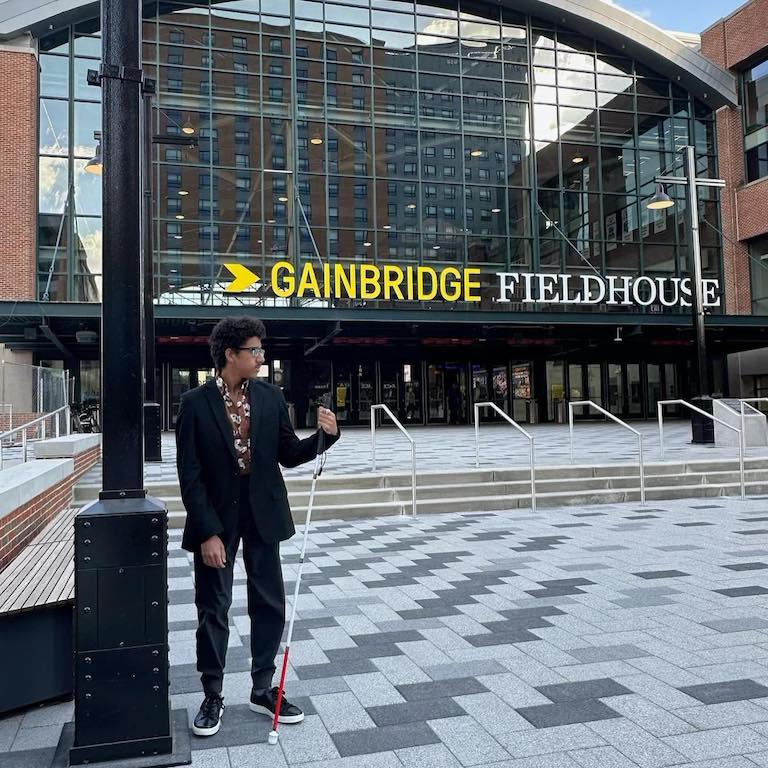
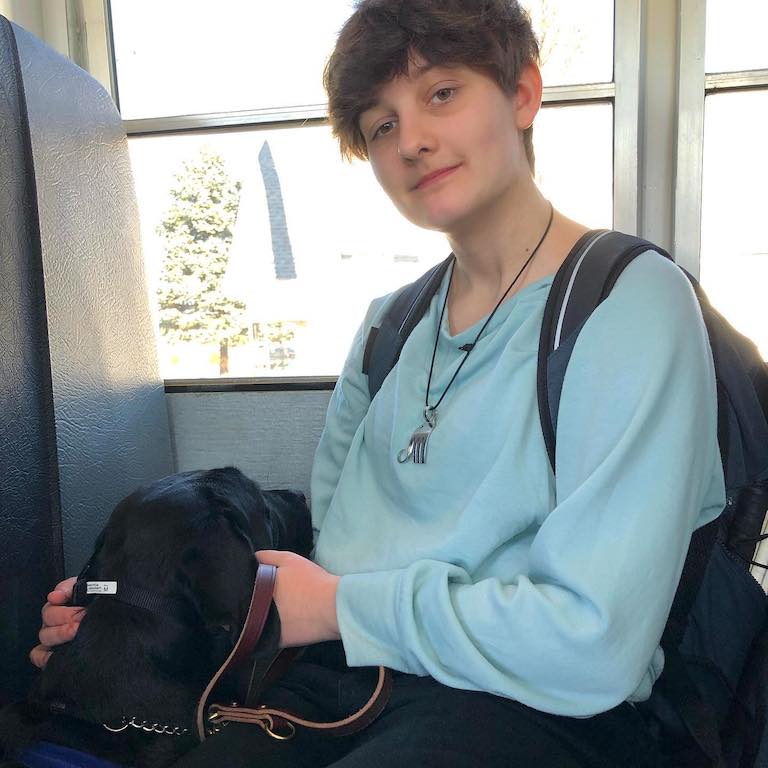
The IndyGo bus system was built with accessibility in mind.
These tactile and audio indicators are essential tools that help visually impaired people have full and empowered lives. We use a mixture of phones and sighted guides to get around comfortably in an unfamiliar environment.
But even the coloration of roadways is important, since vision loss is a spectrum. Although we’re legally blind, many of us benefit from high-contrast designs, which make things more visible. Looking down at the bus platform, Emily and I could tell where the edge of the platform was because it was bright yellow against the regular city cement.
Once the bus arrived, we got in line to board. It was a little frightening to have a gap between the bus and the platform. But with our canes, we were able to feel where the edge was. There were also many tactile descriptions inside the bus, such as lines on the floor to guide us to seating and alert us when we were getting close to the doors.
Our friend and mobility instructor went to inform the bus driver of our disability, so they could alert us when we arrived at our destination. This is crucial for people with visual impairments—or so we thought! We were shocked to hear the stops announced over the speakers, which helped us feel more confident and relaxed.
Emily sat with Morgan on the right side of the aisle and had set their cane in the corner. We were all chatting when there was a horrible sound. I didn’t know what it was, until Mr. Roesch yelled, “CANE!” We all grabbed our canes, and Emily realized that her cane was stuck in the doors, popping the different parts apart to try and ease the pressure. She went into action and quickly pulled it out, thankfully not breaking her cane or the door. (Note to self: Put your cane up to combat cane-eating doors.)
Our first stop was VIPS Indiana in downtown Indianapolis.
Ms. Roesch planned our first stop at the downtown office of VIPS Indiana—Visually Impaired Preschool Services. While we were there, we played with little kids who were legally blind and visually impaired just like us. Both Emily and I met kids that had our exact visual impairments, which was exceptionally interesting to experience.
For most parents, having a child with severe visual impairments can be one of the most stressful and perplexing events of one’s life. A thousand questions race through their heads: Will my baby be able to live a good life? Will they be able to take care of themselves?
It was an honor to meet these parents and answer some of their questions. Emily and I are two exceptionally independent and driven high schoolers, and we are living examples that everything can work out for their children.
Personally, I will never forget talking to a father about his son, who has retinopathy of prematurity just like me. Retinopathy of prematurity is a blinding condition found in premature infants. The father explained how his son had a tendency to take a step when there was a contrast change in floors. I did the exact same thing as a child, but as I developed a better comprehension of the world, I learned to recognize the changes in color and light.
I explained to him how having a visual impairment not only changes how one sees, but how one thinks. It almost has a benefit to it, making you more adaptive. Beaming, he told me just how inspirational and comforting that was to hear!
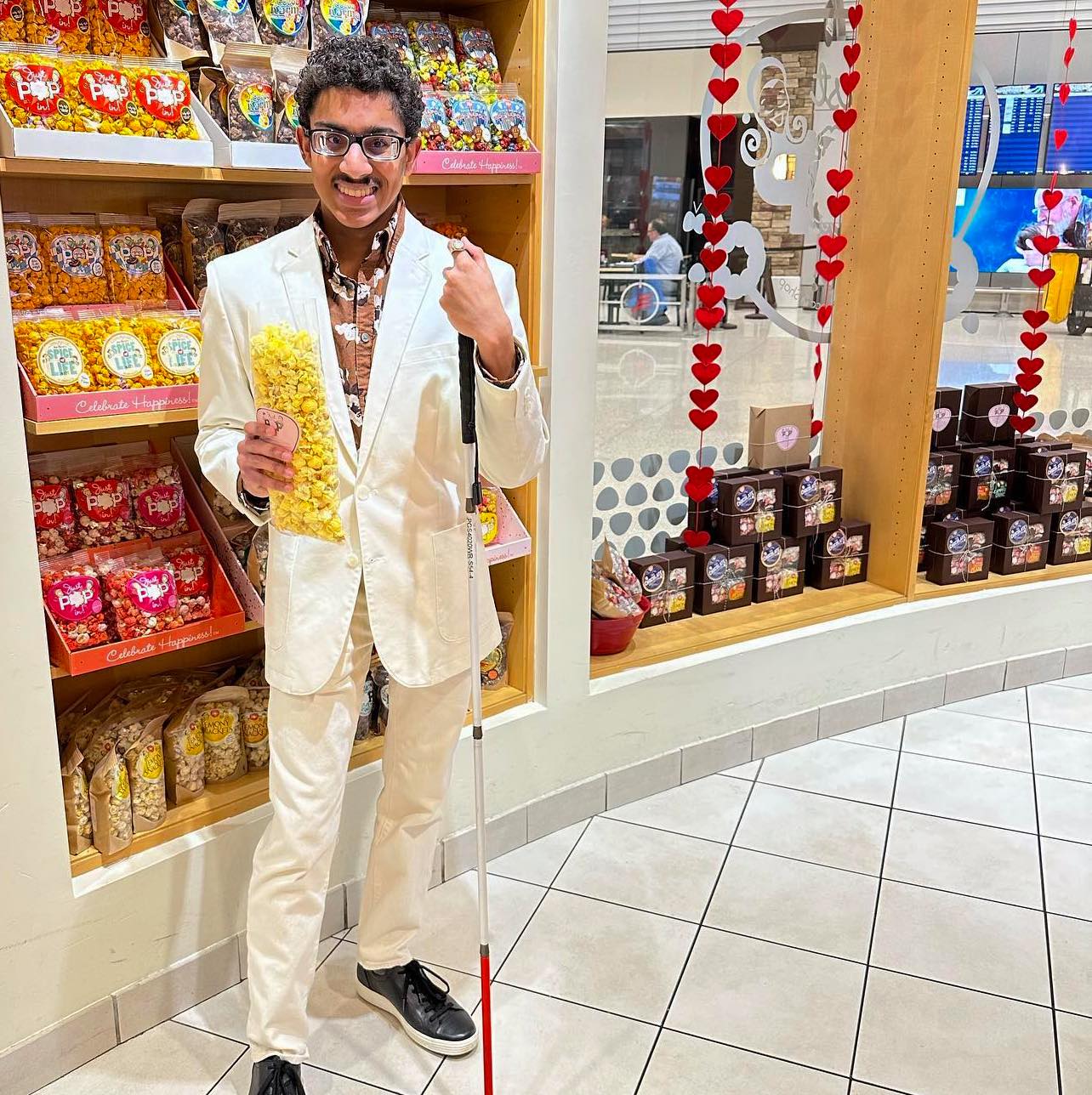
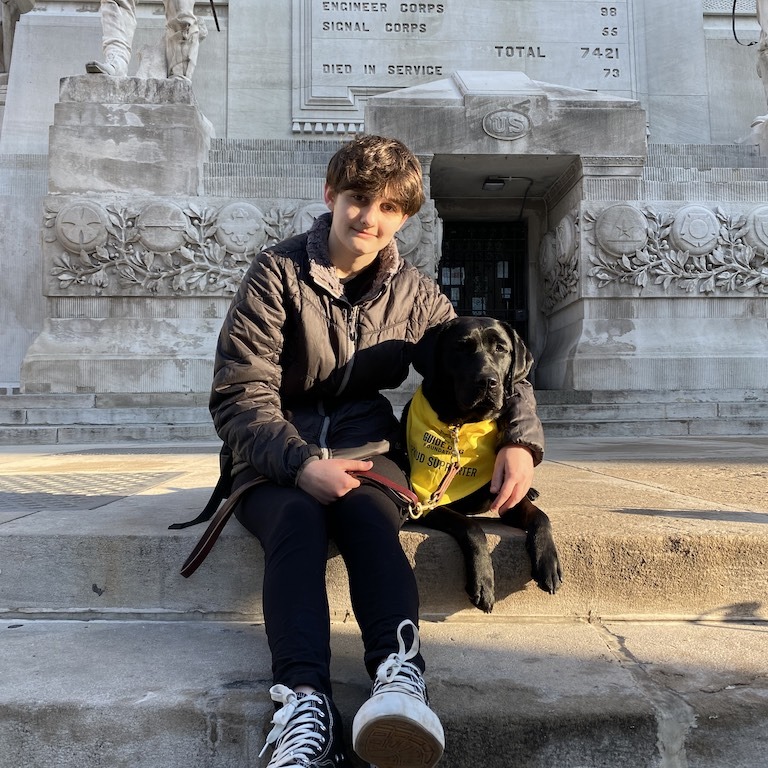
With IndyGo, we spent the day exploring Indianapolis for ourselves.
Ultimately, traveling on the IndyGo buses was an exciting new experience for all of us. After we visited VIPS, we were able to use our phones to find nearby businesses like The Old Spaghetti Factory and Circle Centre Mall. These places made for fabulous little rest stops between our white cane lessons downtown.
For lunch, we had a delicious meal at The Old Spaghetti Factory. The restaurant was beautifully quaint with old-fashioned décor, while still offering modern-day accommodations. As visually impaired individuals, we all found their online menu to be especially useful.
Then, we had a blast walking around and shopping at Circle Centre Mall. We particularly enjoyed Tilt Studio—the arcade inside the mall. The arcade was on the darker side, which made Emily and I get a little lost. But we had a great deal of fun playing all the games in the arcade! Many people are surprised to hear it, but visually impaired people love to game as much as everyone else. Whether it’s Dungeons & Dragons, old-school arcades, or modern-day consoles, it doesn’t take sight to have fun!
Overall, the benefits of this trip downtown were immeasurable. Exploring Indianapolis opened new doors for us and helped build our confidence for the years to come. While our mobility instructor was there with us, it was still our responsibility to find where we were going and how to get there.
Navigating big cities like Indianapolis can be daunting, especially when you’re blind. But it turned out to be one of the most fun experiences we’ve ever had. This journey also showed us just how important it is to live in an accessible city like Indianapolis. As we learned, Indianapolis isn’t just a fun place to be—but also a great place to live if you’re disabled. The city offers ample accessibility options that not all cities have, allowing us to both work and live a fulfilling life.


